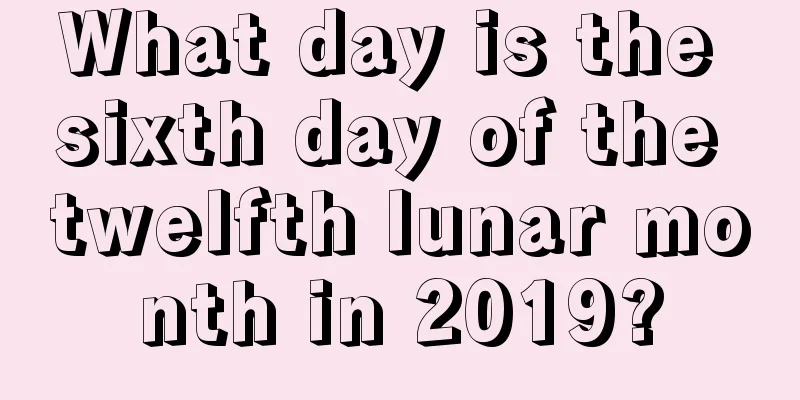The first day of the second lunar month is Zhonghe Festival. What are the customs and cultures?

Introduction: For February, the festival we are most familiar with is the Dragon Raising its Head Festival. However, few people know that there is also a festival called the Zhonghe Festival the day before February 2, which is the first day of February. What is Zhonghe Festival? What are the traditional customs and activities of this festival? Let’s follow the editor to learn more about it below! Mr. Shui Mo summarized many festivals and solar terms in the second month of the lunar calendar to help people better understand how to face every day in February.February 1: Zhonghe FestivalNowadays, old Nanjing people, especially farmers, still like to say "On the second day of the second month (lunar calendar), the dragon raises its head." In fact, in the past, the first day of February before this day was a very grand "Zhonghe Festival". Li Mi, an official in the Tang Dynasty, once wrote to Emperor Dezong, saying that there were many festivals in the first month of the year but no festivals in the second month, and requested that February 1 be designated as the Zhonghe Festival to pray for a good harvest. All officials submitted their approval one after another, and thus this festival was decided. Later, people combined the Zhonghe Festival with the sacrifice to the God of Land and Grain, and included the birthday commemoration of the God of Land on the second day. However, the original name of the festival, "Zhonghe Festival", was gradually forgotten.Zhu Yuanzhang offered sacrifices to the gods and grain on the first day of FebruaryThe ancients often said: "The most important affairs of a country are sacrifices and wars." "Si" means sacrifice, and "rong" means military affairs. In other words, the way to govern a country lies in combining civil and military skills, neither of which can be missing. From emperors, generals, and officials to scholars and common people, everyone refers to the country as "sheji". "She" is the god of the land; "Ji" is the god of the five grains. Throughout the dynasties, both the state and the people have offered sacrifices to the gods of the community and the gods of millet. Especially the imperial court, it is even more important to establish the altars of society and the altar of grain.Nanjing is the ancient capital of six dynasties, but the first dynasty to establish its capital here, "Dongwu", was an exception. At that time, many officials of the Eastern Wu State submitted petitions requesting to build altars to the gods such as She and Ji. However, the Wu Emperor Sun Quan said, "All under heaven belongs to the king," meaning that all the land under heaven belongs to the royal family and there is no need to do so. Therefore, the "Six Dynasties Records" said: "At the end of the Wu Dynasty, there was no time for rituals and etiquette. The ancestral temples and altars of the country are not recorded in history." The court officially began to build a national altar in Nanjing in the first year of Jianwu in the Eastern Jin Dynasty. Three altars were built, including a She Altar and a Ji Altar. All subsequent dynasties established their capitals in Nanjing, though the location and position varied from time to time. When Emperor Taizu of Ming Dynasty, Zhu Yuanzhang, was building the palace, he carefully considered the rituals of past dynasties and felt that it was inappropriate to offer sacrifices to the shrine and the god of millet separately: "It is believed that the five soils (i.e. the shrine gods) produce the five grains (i.e. the millet gods), which are used to support the people. If they are offered sacrifices to separately, it would seem that the meaning of creating life has no purpose, so we combine them into one." Therefore, Zhu Yuanzhang combined the shrine and the millet altar into one and named it "Sheji Altar". According to the research of the late famous Nanjing scholar Mr. Zhu Ke, to the south of the Wumen Gate and to the left of the Duanmen Gate of the Ming Palace in Nanjing is the "Sheji Altar" (now abandoned)... Referring to the "Map of the Palace City in the Ming Dynasty" restored by Mr. Zhu, it can be seen that the Sheji Altar is adjacent to the west and is close to the central axis of the Ming Palace Ruins Park that now exists in Nanjing Wuchao Gate. Mr. Zhu's "A Survey of Ancient Monuments in Nanjing" believes that the Sheji Altar in Nanjing "is of comparable status to the Sheji Altar in the Forbidden City in Beijing... Its structure is exactly the same as the Sheji Altar in Beijing." The most grand spring ceremony to worship the state and the people in Nanjing's history was held on the first day of February in the first year of Hongwu (1368). Zhu Yuanzhang personally led hundreds of officials to the Altar of Land and Grain, performed the ceremony of three bows and nine kowtows, offered three animals and other sacrifices, and the orchestra played sacrificial music and performed dances that displayed literary, moral and military achievements. Nanjing also performed community dramasLocal areas also hold activities to worship the gods and grain, adhering to the "cultural heritage" passed down from ancient times. According to custom, in most parts of our country, altars to the state and grain were built in prefectures, states, and counties. As recorded in "New Records of Nanjing in the Zhizheng Period", the altars of society and grain in Nanjing during the Yuan Dynasty included: the Fu Altar, located behind the ancient "Yuecheng" outside the South Gate, covering an area of 10 acres, surrounded by a wall, with altars for the gods of She, Ji, Feng, Lei, Yushi, etc., as well as palaces and other buildings; the Shangyuan County Altar, outside the Baixia Gate; the Jiangning County Altar, to the west of "Xiuchun Garden" in the southwest of the county, etc.On the first day of February, the local governor of Nanjing presided over the sacrifice at the Altar of Land and Grain, and his colleagues accompanied him. They wore official uniforms and performed the sacrificial ceremony according to the procedures, being extremely respectful and without any mistakes. After the officials finished their memorial service, the masses, men, women, old and young, came in their best clothes and offered incense, candles, tea, wine and other offerings. Ordinary people also perform community plays, drink community wine, and eat community meals. There is a poem in ancient poetry about the community day that goes: "Every family helps the drunk person go home", which is a portrayal of the grand occasion. During the Six Dynasties, the community rice in Nanjing was cooked with pork offal and then spread on rice. Some people believe that the "rice with gravy" eaten by Nanjing people today is a relic of the ancient community rice. The activities of offering sacrifices to the land and grain have basically been associated with feudal society. After the success of the Xinhai Revolution, Mr. Sun Yat-sen established the Republic of China in Nanjing and implemented a republican system. "The country and the people" are no longer the private property of the royal family. As the concept of "country" gradually gained popularity, people no longer used the term "sheji" to refer specifically to the country. But for thousands of years, the activities and concepts of offering sacrifices to the land and grain have always played a role in uniting the country, the nation, and the society. The spirit of patriotism and love for the homeland in modern times is also a reasonable inheritance and development of the essence of its ideas. Worship the Sun GodIn the past, people believed that the birthday of the sun god was on the first day of the second lunar month, so this day was also regarded as the "birthday of the sun" and sacrifices were offered to the sun.In the past, on this day, Nanjing people would go to Taoist temples, or face the paper image of the Sun God at home, burn incense and candles to worship, and offer "Sun Cake" to the Sun God. The method of making this cake is to use rice flour dough to make a round cake shape and sandwich sugar in the middle. Some cakes have chicken patterns printed on them using molds, while others have a chicken molded out of rice flour, both symbolizing the sun god standing next to a golden rooster. The golden rooster pattern originated from the ancient people's association between sunrise and rooster crowing: they believed that the golden rooster (the divine rooster) lived in the sun, and when the sun rose and illuminated the earth, the roosters on earth also crowed in response. The local documents "Yanjing Miscellaneous Notes" and "Tianzhi Ouwen" which record Beijing in the Ming and Qing Dynasties state: "On the first day of February, incense is burned at the Sun Palace (Taoist temple), and people offer sacrifices to the sun with rice cakes, on which colored noodles are made in the shape of chickens... In early February, sun cakes are sold on the streets, once a year, and people buy them to offer sacrifices to the sun." This custom still existed in Beijing until the 1930s. Summary: After reading the introduction in the above article, it turns out that there are these customs on the first day of February. You can learn about them and increase your understanding of traditional culture! You have finished reading this article. For more exciting content, please check out the special topic of the second month of the lunar calendar! |
Recommend
Can I travel on the 17th day of the first lunar month in 2019? Is my fortune good?
The Chinese New Year is over, and people who work ...
Is June 23rd of the lunar calendar 2022 a Zodiac day? Can I pray?
I believe everyone is familiar with praying, so le...
What’s a good homophonic name for a baby with the surname Yang?
An auspicious name can bring good luck to people. ...
Can I get married on the 28th day of the first lunar month in 2019? Can I get engaged and hold a wedding?
Shuimoxiansheng.com provides you with more conten...
Lunar August 27, 2019: Good and bad luck, good and bad luck
The days in the lunar calendar have a distributio...
What is the meaning of hanging sachets during the Dragon Boat Festival? What can be put in the sachets to ward off evil spirits and bring blessings?
Introduction: The Dragon Boat Festival is known as...
Is it a good time to worship ancestors on the 20th day of the seventh lunar month in 2021? Is your fortune good?
China has had the custom of worshipping ancestors ...
What is the fate of a boy born on December 19th of the lunar calendar in 2021?
The fate of a boy is related to the time of his bi...
Is the second day of the fifth lunar month in 2019 a good day to burn incense and worship Buddha?
To worship Buddha and Bodhisattva and eliminate ka...
How many days until Halloween 2021? Why do we make pumpkin lanterns for Halloween?
In late summer and early autumn, Halloween comes. ...
Is life good for people born in the year of the tiger during the Cold Dew? How to bring good luck during the Cold Dew in 2021?
For Chinese people, the fortune of the zodiac sign...
What is the lunar calendar for the Ghost Festival on July 15, 2022? Is it an auspicious day to propose?
The seventh lunar month is already halfway through...
Is it possible to get married on the 12th day of the 12th lunar month in 2020? Is it an auspicious day?
When the twelfth lunar month comes, the winterswe...
What is the fortune of a boy born on the ninth day of the eighth lunar month in 2021? Is he lucky?
In August, the ground is filled with the fragrance...
What is the zodiac sign of a baby born in October of the lunar calendar in 2020?
What is the zodiac sign of a baby born in October ...









